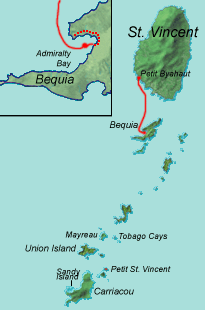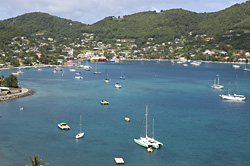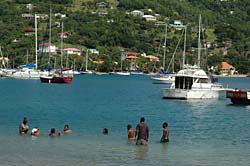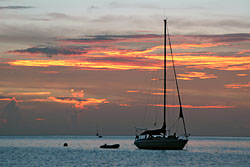


|
Today was the day we left on our sail boat section of our trip. In the morning, we packed up. Everything was damp. It must have been so humid yesterday that when the temps dropped, water condensed on everything. Not like the dew we get up north, but everything was damp just the same. So we packed up in sections. Things that were dry were separated from things that were wet, things that were dirty were separated from things that were clean (Joel's hiking shirt was separated from everything else). Eventually we were all packed up except for the things we had asked Petit Byahaut to wash for us yesterday. Brian said they would have them ready this morning (1).
We had the usual for breakfast, a fruit plate and eggs. Then we went out for our last swim in the bay. The water was cloudy compared to other days. And there were jelly combs floating by. We saw some with wings which they used to propel themselves along. The jelly combs were very beautiful, clear all the way through with phosphorescent lights running up and down their sides. Some of their lights were blue, some had green lights, and some red, but they were all beautiful.
 |
I (Daphne) got a slight sting that went away quickly. Then, when we returned to shore, we looked up the jellyfish in the reef creature identification books. One of the jellies I saw was a true jelly fish; the others were combs, and jelly combs don't sting. I forget the name of the jelly fish I saw but it was very small and had little nodules hanging down.
When we finished out swim, Jeremy, Fortitude's owner and captain, was coming in (by dingy) to pick us up. He showed us around the sailboat that would be our home for the next five nights, and introduced us to his mate, Vanessa. Jeremy also want over the rules of the boat -- always hold onto something when walking on deck, take your shoes off when entering the boat, always secure all you gear in case the boat heels, etc. He also showed us how to use the toilet (2).
We were headed for Bequia (bec-way) today. Jeremy said it was 10 miles away. There was no wind at all in the lee of the island, but once we got past St. Vincent, we zipped along quickly. On the way we saw a small pod of dolphins.
 |
During the ride, I was reading Jeremy's guide book. It was a sailor's guide book so had information about the island that a sailor would need. My guidebooks just had the points of interest, but the sailing guide book had all the information about the channels, and how to get from one island to another, and what supplies are available on each island, and where you can fix your boat and get parts (3). A slightly different slant for a guidebook.
The sailboat pulled into Admiralty Bay, the main harbor in Bequia, next to the main town, Port Elizabeth. Once Jeremy found a mooring spot he liked, he dropped anchor. We had lunch on board the boat not long after we got to the harbor. I had salad, Joel had bread and cheese and Danish salami.
Bequia is both more and less pretty than St. Vincent. The town (Port Elizabeth) is charming and seems to be kept up well. In contrast, St. Vincent seems much more run down and the people seem very impoverished (4). But the island of St. Vincent is stunning with the volcano that rises 4000 feet in the air. Jagged peaks everywhere and many of the houses built on the hill side. Bequia doesn't have a volcano; it's beaches seem yellow and not black like St. Vincent's. There is very little obvious agriculture on Bequia; the houses all have their little gardens, but no major banana farms. Jeremy tells us it has become a great island for the sailboats since you can get anything you need for your sailboat here.
 |
After lunch we went for a walk up to one of the main "forts", scattered around the island. The fort we visited, on the point at the West end of the North shore of Admiralty Bay, wasn't really a fort, but just a gazebo with some canons. But it had a wonderful view of Port Elizabeth. The hike up, however, was hot. The hill was steep, but very short. Joel and I were feeling little twinges from our hike up the volcano in our calves. All the houses seemed to have gardens and goats. And a few dogs wandered around looking very hot.
During out short hike to the fort, I had a footwear failure. My sandals, which I have had forever, started chafing my toe. By the end of our hike, it had gotten quite annoying and no amount of makeshift padding seems to alleviate the rubbing. It was obvious that I needed a new pair of sandals, and fast (5). The good news was that we were in a tourist town, Port Elizabeth.
 |
And now for our scheduling flaw. During our entire time in the Grenadines, we never looked at a newspaper, or television screen, or even listened to the radio. Every day was the same as every other. But, that was not really true. Since we arrived on St. Vincent on Wednesday night and stayed four nights, we pulled into Bequia on Sunday. We wanted to see all the shops, but of course they were all closed for Sunday. Bad timing on our part. If we had left Boston a day later we would have hit Port Elizabeth on Monday. But all is not lost. We would stay overnight in Admiralty Bay and go into Port Elizabeth the next morning.
After our short hike, it was time to get wet. Joel didn't want me to go out to the sea grass beds where the turtles were (because of the high level of boat traffic) so I hung out close to the boat and explored there. I saw huge flying gurnard and some squid. I also saw a weird worm crawling along some of the algae.
I thought I would just stay in my bathing suit all day long, but it doesn't dry that quickly and I was tired of being wet. So I get dressed for dinner and will probably do the same for the rest of our time on the sailboat. Our first dinner on the sailboat was jerked pork. Jeremy cooked it on the little barbeque grill attached to the side of the boat. After eating we were tired, so we laid down in bed and read our books for a while before falling asleep.
|
Footnote 1: We knew that laundry was going to be a challenge on the trip. We did not want to pack for two full weeks, since we wanted to travel light. That meant that we would have to do laundry while traveling. The sailboat has no washing facilities, and although they would put into port for us to use a laundry mat, we did not want to spend our vacation sitting in a laundry mat. So we planned on having the two resorts, Petit Byahaut and Petit St. Vincent, do laundry for us. On the morning of July 17th, we dumped a pile of dirty clothes on Brian and asked him to have them washed. They were washed that morning, but Petit Byahaut has no clothes dryer, so the clothes had to air dry. This took all day and all night, and we got them back the morning we were scheduled to leave. As for the second cleaning, well, you can read about our experiences with Petit St. Vincent's laundry service later in the journal. Fortunately, attire on the sailboat was just bathing suits and sun shirts.
Footnote 2: It seems that everyone who is considering a trip on a sailboat spends an inordinate time worrying about the sailboat's toilet. I know we did. When we first schedule the trip, we were given a list of a few boats that were available. The first question we asked of each was, not how much they cost, but whether they has electric toilets. Cat Maudy, the sailboat we were on in the Virgin Islands had electric toilets. But all the boats in the Grenadines, had manual toilets, including Fortitude.
Anyway, after doing your business, you flip the lever one way, pump a few times to put water in the bowl. Then you flip the lever the other way and pump a bunch to move the contents of the bowl through the plumbing. Then you flip the switch and let the electric motor move everything to its final resting place. Then turn off the motor and flip the lever back. Or, do you flip the lever back? And do you pump a few times again when you are done, or not? Daphne and I could never remember and that lever, which was always supposed to be left in one position or the other, wasn't. Oh, well.
Footnote 3: One of the things mentioned in the guidebook was "Daphne's Boutique" in Port Elizabeth. Well, since we were in Port Elizabeth, I had to go out of my way to find Daphne's Boutique and take a picture. We never went inside, however.
Footnote 4: Part of our perceptions of the level of affluence of the natives has to do with the places we visited. At St. Vincent, we drove through a few of the non-tourist towns on the windward coast on our trip to the volcano. But on Bequia, we pulled into a tourist town, whose whole purpose seems to be to cater to the rich yachters who visit, re-supply and moor in the bay. But there is poverty on Bequia as well, consider this picture showing the contracts between the classes on Bequia.
Footnote 5: Daphne was not the only one who needed to do some shopping. While hanging out on the sailboat in Admiralty Bay, my hat blew off in the wind and landed in the water. At the time Jeremy was swimming around and he was gallant enough to dive under the boat and rescue my hat from the ocean bottom. But it made me realize that I really needed a backup hat.
My hat was not the only thing that Jeremy found on the ocean bottom under the boat. He also pulled up a small glass bottle that contained an octopus. After dropping the octopus on the desk for us to gawk at (just like tourists), he let it free (the octopus, not my hat).
Footnote 6: It is worth nothing that Naturapel brand of insect spray worked to completely keep the biting gnats off out legs. We recommend that anyone who visits the island bring this (or some other brand) of insect spray.
![]()
![]()
Introduction |
July 14th (travel day) |
July 15th (Falls of Baleine) |
July 16th (Petit Byahaut) |
July 17th (La Soufriere hike)
July 18th (sail to Bequia) |
July 19th (Union Island) |
July 20th (Sandy Island) |
July 21th (Tobago Cays) |
July 22th (Petit Tobac)
July 23th (arrive at PSV) |
July 24th (West Side Beach) |
July 25th (Atlantic Beach) |
July 26th (Mopion) |
July 27th (travel day)
Photo Galleries
GouldHome | Travel Journals
Text and images © Copyright 2004 Daphne and Joel Gould. All Rights Reserved.
For comments or suggestions about this site contact Daphne Gould.